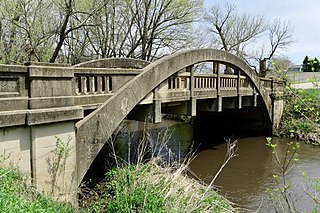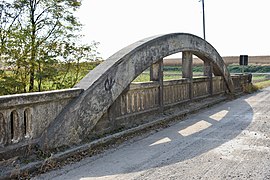
James Barney Marsh was an American engineer and bridge designer. He patented a new design for arch bridges. Marsh gave Archie Alexander, the first African-American to graduate as an engineer from Iowa State University, his first job. Marsh worked in the bridge building business for over 50 years, and several of his bridges are listed in the National Register of Historic Places.

Wilson River Bridge, also known as Wilson River Bridge at Tillamook or Wilson River Bridge No. 01499, is a bridge near Tillamook, Oregon, United States. The 1931 bridge was designed by Conde McCullough in the Classical Revival and Art Deco styles. It covers a span of 180 feet (55 m) and brings coastal U.S. Route 101 (US 101) over the Wilson River.

The Marsh Engineering Company was a company that designed many significant bridges in the United States, including a number that survive and are listed on the National Register of Historic Places. It was located at 206 Masonic Temple in Des Moines, Iowa.

The Court Avenue Bridge is a historic structure located in downtown Des Moines, Iowa, United States. It became a contributing property in the Civic Center Historic District in 1988, and was individually listed on the National Register of Historic Places on May 15, 1998 as a part of the Highway Bridges of Iowa MPS.
N. M. Stark and Company, of Des Moines, Iowa, was a firm active in building bridges in Iowa.

Hawkeye Creek Bridge is a historic structure located in a rural area northeast of Mediapolis, Iowa, United States. The Des Moines County Board of Supervisors contracted with Clinton Bridge and Iron Works on September 23, 1909, to design and build this bridge. It is an 80-foot (24 m) span that carries traffic of a gravel road over Hawkeye Creek. The structure is a single rigid-connected Pratt through truss that is supported by concrete abutments. It basically remains in an unaltered condition. The bridge was listed on the National Register of Historic Places in 1998.
The Des Moines River Bridge is a historic bridge located southwest of Swea City, Iowa, United States. It spans the Des Moines River for 102 feet (31 m). In February 1916, the Kossuth County Board of Supervisors approved the contract for the Des Moines Marsh Engineering Company to build the bridges. It was designed by the company's engineer James B. Marsh. The 9-panel Marsh fixed arch bridge, also known as a "rainbow arch", was completed in 1916 for $7,150. It features two tapered concrete arches that carry the roadway in between them from hangers. It was listed on the National Register of Historic Places in 1998.
The Minerva Creek Bridge is located in Liberty Township north of Clemons, Iowa, United States. It spans Minerva Creek for 68 feet (21 m). The Marshall County Board of Supervisors awarded a $14,090 contract to the N.M. Stark and Company of Des Moines to build six concrete bridges. They were all designed by W.W. Morehouse, the Marshall County Engineer. This single-span concrete Luten arch bridge was completed the same year for $2,550. It was the longest of the six bridges in the contract. The bridge was listed on the National Register of Historic Places in 1998.
The Squaw Creek Bridge was located in Harrison Township in rural Boone County, Iowa, United States. It spanned Ioway Creek, formerly named Squaw Creek, for 76 feet (23 m). The Boone County Board of Supervisors awarded a contract to the N.E. Marsh & Son Construction Company of Des Moines in August 1917 for $6,278. Designed by Des Moines engineer James B. Marsh, the Marsh arch bridge was completed the same year. The bridge was listed on the National Register of Historic Places (NRHP) in 1998. It has subsequently been replaced by a new span. The bridge was removed form the NRHP in 2022.

Beaver Creek Bridge is located northwest of Ogden, Iowa, United States. It spans Beaver Creek for 52 feet (16 m). The Marsh arch bridge was designed by Des Moines engineer James B. Marsh, and built by the N.E. Marsh & Son Construction Company of Des Moines in 1919. After it was completed it carried traffic on the Lincoln Highway. The bridge was listed on the National Register of Historic Places in 1998.

Big Creek Bridge 2 is located northeast of Madrid, Iowa, United States. It spans Big Creek for 53 feet (16 m). The Marsh arch bridge was designed by Des Moines engineer James B. Marsh in February 1917. The contract to build the structure was awarded in April of the same year to the N.E. Marsh & Son Construction Company of Des Moines for $3,170. It was completed later in 1917. The bridge was listed on the National Register of Historic Places in 1998.
The Beaver Creek Bridge was located northwest of Schleswig, Iowa, United States. It spanned Beaver Creek for 134 feet (41 m). Steel was in short supply during World War II as a part of the war effort. Many bridges built across the state were built in this era with timber, especially small-scale bridges. Heavy flooding washed out 27 bridges and culverts in Crawford County in May 1945. The county board of supervisors used emergency funds to build new bridges. They bought several steel superstructures from the Des Moines Steel Company to replace the wash-out spans. The bowstring arch-truss structures appear to have been designed by H. Gene McKeown, a civil engineer from Council Bluffs. This bridge was one of several similar structures built in the county. The bridge was listed on the National Register of Historic Places in 1998, and it was delisted in 2020.
The Beaver Creek Bridge was a historic bridge located to the east of Perry, Iowa, United States. The 100-foot (30 m) span carried traffic on M Avenue over Beaver Creek. The Dallas County Board of Supervisors bought a rainbow arch bridge design from Des Moines engineer James B. Marsh. They contracted with his son Frank who owned F.E. Marsh & Co. of Jefferson, Iowa to build the bridge for $8,075. The bridge was listed on the National Register of Historic Places in 1998. It has subsequently been removed and replaced.
The Rockwell City Bridge is located just east of Rockwell City, Iowa, United States. The 60-foot (18 m) span carried traffic on 270th Street over an unnamed stream. In 1915 Calhoun County requested the Iowa State Highway Commission (ISHC) and Des Moines engineer James B. Marsh to design a bridge for this crossing. The ISHC designed a double span concrete girder structure, while Marsh submitted his patented single-span rainbow arch configuration. They chose the Marsh submission, and contracted with the Iowa Bridge Company to build six bridges for $11,690, which included the costs for this bridge at $4,107.65. Originally built to serve a county road, it was later incorporated into the route for U.S. Highway 20 and carried heavy traffic until the highway was realigned in 1981. While no longer in use, the bridge remains in place just south of the replacement span. It was listed on the National Register of Historic Places in 1998.

The Mederville Bridge is a historic structure located in the unincorporated community of Mederville, Iowa, United States. It spans the Volga River for 156 feet (48 m). This is one of only a few open spandrel arch bridges constructed in Iowa. Designed by the Marsh Engineering Company of Des Moines, it replaced a covered timber Howe truss bridge. Clayton County rejected all of the original bids to build the structure when they all came in too high. Six companies bid a second time on the project, and F. E. Marsh and Company of Des Moines won. They completed in the bridge in 1918 for $17,454.32. It was listed on the National Register of Historic Places in 1998.
Stoe Creek Bridge was a historic structure located northwest of Oelwein, Iowa, United States. It spanned Stoe Creek for 38 feet (12 m). In June and July 1913, the Fayette County Board of Supervisors awarded contracts for several small bridges in the county. The Iowa State Highway Commission designed this single span bridge that was built by N.M. Stark and Company of Des Moines. It was completed in 1914 for $1,654. The bridge was listed on the National Register of Historic Places in 1998. It was replaced in 2007.

The Dunkerton Bridge is a historic structure located in Dunkerton, Iowa, United States. The span carried a local street over Crane Creek for 212 feet (65 m). The three-span, filled spandrel arch bridge was built by the Marsh Engineering Company of Des Moines in 1909. It replaced an older span at a different location. The bridge served as the major entry point into the town from the north. This bridge was also replaced by a newer bridge to the east, and this span now carries pedestrian traffic between Charma Park and Marble Street into downtown Dunkerton. It was listed on the National Register of Historic Places in 1998.

East Indian Creek Bridge is a historic structure located southeast of Nevada, Iowa, United States. It spans East Indian Creek for 78 feet (24 m). N.M. Stark and Company of Des Moines started building bridges for Story County beginning in 1902, and then they held an exclusive contract until 1913 when the Iowa Legislature banned the practice. Stark constructed this concrete Luten arch structure in 1912 for $4,462 as part of a multi-bridge contract. This was the longest concrete arch built by Stark in Story County. It was listed on the National Register of Historic Places in 1998.
The Fish Creek Bridge is a historic structure that was originally located east of Salem, Iowa, United States. The span carried Hickory Road over Fish Creek for 50 feet (15 m). It is a small-scale, wrought-iron bridge that the Henry County Board of Supervisors bought from the George E. King Bridge Company of Des Moines in 1893 for $410.80. It was believed to have been fabricated by their parent company, King Iron Bridge Company of Cleveland, and assembled by local laborers. Its historical significance derived from its being an uncommon variant of the Pratt truss. It was listed on the National Register of Historic Places in 1998. Subsequently, the bridge has been replaced at its original location, and the historic structure was moved to Oakland Mills Park.

Big Creek Bridge was a historic structure located northeast of Madrid, Iowa, United States. It spanned Big Creek for 43 feet (13 m). The Marsh arch bridge was designed by Des Moines engineer James B. Marsh. It was completed in 1916. The bridge was listed on the National Register of Historic Places in 1998. The historic span was replaced by a new bridge in 2004.















